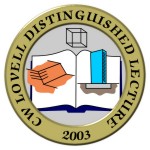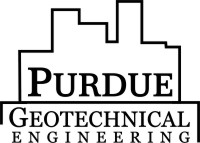
5th C.W. Lovell Distinguished Lecture
| - |
October 5, 2006
James K. Mitchell
Geotechnics: The Past, The Present, and Future Challenges and Opportunities
Geotechnical engineering has evolved over the past half century from a soil mechanics and foundation engineering based component of civil engineering to a field with many sub-disciplines that provide earth system information, data, analysis, design, and construction services required to meet a broad range of societal and environmental needs. Important developments during the 20th Century are reviewed, the current status of the discipline is assessed, major unresolved issues are identified, and challenges that must be overcome in resolving these issues and for the development of new and better geosolutions are identified. The promise and potential for application within geotechnics of new and emerging technologies such as biotechnology, nanotechnology, sensor technology, geophysical and remote sensing methods, and information technology are assessed. The potential for enhanced geotechnical contributions to virtually all earth related aspects of infrastructure needs, protection against the ravages of natural disasters, and environmental enhancement in new and exciting ways is great.
About James K. Mitchell
| - |

Dr. James K. Mitchell received his Bachelor of Civil Engineering Degree from Rensselaer Polytechnic Institute in 1951, Master of Science in Civil Engineering Degree from the Massachusetts Institute of Technology in 1953, and the Doctor of Science Degree in Civil Engineering, also from M.I.T., in 1956.
Following several months as a Soil Engineer at the U.S. Army Corps of Engineers' Waterways Experiment Station in Vicksburg, MS, he served for two years on active duty in the U.S. Army in the U.S. and Germany. He was appointed to the faculty of the University of California, Berkeley in 1958 and held the Edward G. Cahill and John R. Cahill Chair in the Department of Civil Engineering at the time of his retirement from Berkeley in 1993. Concurrently he was Research Engineer in the Institute of Transportation Studies and in the Earthquake Engineering Research Center. He developed and taught graduate courses in soil behavior, soil and site improvement, and foundation engineering as part of the Geotechnical Engineering Program within the Civil Engineering Department. He served as Chairman of the Department of Civil Engineering at UC Berkeley from 1979 through 1984. He was appointed the first Charles E. Via, Jr. Professor in the Via Department of Civil Engineering at Virginia Tech in 1994, University Distinguished Professor in 1996, and University Distinguished Professor, Emeritus, in 1999.
His primary research activities focus on experimental and analytical studies of soil behavior related to geotechnical problems, admixture stabilization of soils, soil improvement and ground reinforcement, physico-chemical phenomena in soils, environmental geotechnics, the stress-strain time behavior of soils, in-situ measurement of soil properties, and mitigation of ground failure risk during earthquakes. He has supervised the dissertation research of 74 Ph.D. students and authored more than 350 publications, including the graduate level text and geotechnical reference, "Fundamentals of Soil Behavior." During the 1960's and early 1970's he served as the National Aeronautics and Space Administration's Principal Investigator for the Soil Mechanics Experiment, which was a part of Apollo Manned Missions 14-17 to the Moon.
Dr. Mitchell serves as a consultant to numerous governmental and private organizations, both nationally and internationally. Recent and currently active projects include the evaluation of seismic stabilities and design of liquefaction mitigation options for Success Dam and Isabella Dam (U.S. Army Corps of Engineers), the Folsom Project (U.S. Bureau of Reclamation), and San Pablo Dam (East Bay Municipal Water District) in California, Pineview and Deer Creek Dams in Utah (U.S. Bureau of Reclamation), Tuttle Creek Dam in Kansas (TreviIcos Corporation), Coquitlam, Keenleyside and Terzaghi Dams (BC Hydro), and the three dams of Duke Energy's Bridgewater Project in North Carolina (Devine, Tarbell & Associates); the Embankment Technical Review Board for the Third Runway at Seattle-Tacoma International Airport, the Seismic Safety Peer Review Panel for the Bay Area Rapid Transit System, and foundation densification using explosive compaction at Seymour Falls Dam in British Columbia (Klohn-Crippen). He is a member of the A.S.C.E. External Review Panel for the Performance Evaluation of Hurricane and Flood Protection Projects in S.E. Louisiana.
He is a licensed Civil Engineer and Geotechnical Engineer in California and Professional Engineer in Virginia. He is a Fellow and Honorary Member of the American Society of Civil Engineers. He has served ASCE in various other capacities over the years. He was Chairman of the Transportation Research Board Committee on Physico-Chemical Phenomena in Soils from 1966-1973, and was a member of the TRB Executive Committee from 1983-1987. He was Chairman of the Geotechnical Board of the U.S. National Research Council (NRC) from 1990 through 1994 and Vice President of the International Society for Soil Mechanics and Geotechnical Engineering from 1989-1994. He has also served on boards and committees of the NRC and the National Academies.
Dr. Mitchell was awarded the Norman Medal in 1972 and 1995, the Thomas A. Middlebrooks Award (four times), the Walter L. Huber Research Prize, the Terzaghi Lecture Award, the Karl Terzaghi Award, the H. Bolton Seed Medal (2004) and the 2006 Outstanding Projects and Leaders Award (OPAL) in Education, all from the American Society of Civil Engineers; the Distinguished Teaching Award and the Berkeley Citation from the University of California; the Western Electric Fund Award of the American Society for Engineering Education; the Medal for Exceptional Scientific Achievement from the National Aeronautics and Space Administration, the U.S. Army Corps of Engineers' Chief of Engineers Outstanding Service Award in 1999, and was the recipient of the 2001 Kevin Nash Gold Medal of the International Society for Soil Mechanics and Geotechnical Engineering. He was the 1991 Rankine Lecturer of the British Geotechnical Society and delivered the Nabor Carrillo Lecture of the Mexican Geotechnical Society in 2004. He was elected to membership in the United States National Academy of Engineering in 1976 and the U. S. National Academy of Sciences in 1998. He served as the 2003-2005 Chair of the Civil Engineering Section of the National Academy of Engineering.
Program
| - |
| 9:30 a.m. | |
| 12:00 p.m. | Potluck (CIVL G212) |
| 4:30 p.m. | Lecture (Fowler Hall, Stewart Center) |
| 6:30 p.m. | Reception and dinner (West Faculty Lounge, Purdue Memorial Union) |
Photos of 5th C.W. Lovell Distinguished Lecture
| - |


